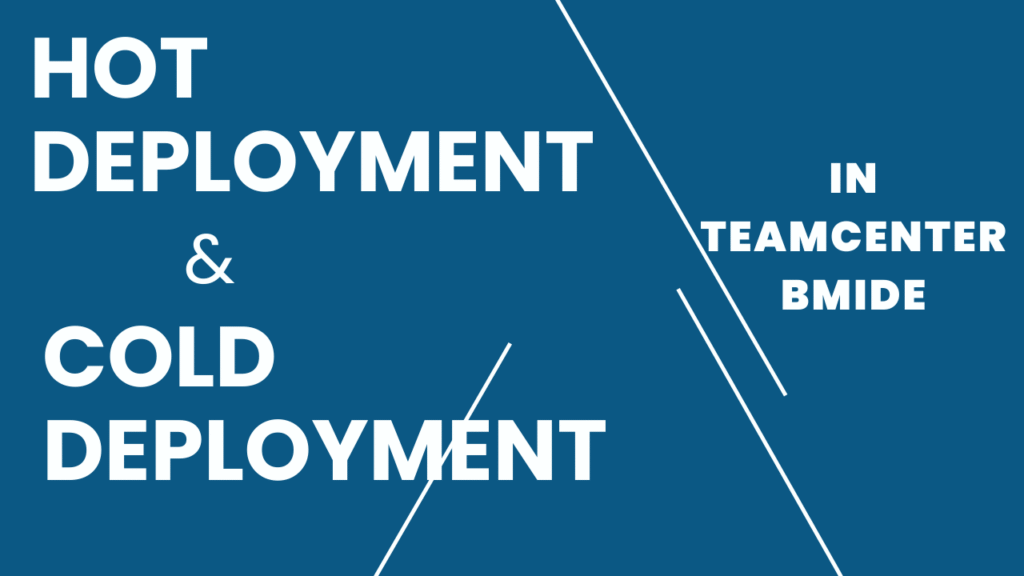Teamcenter BMIDE (Business Modeler Integrated Development Environment) is a powerful tool used for customizing and configuring Teamcenter PLM (Product Lifecycle Management) software. One of the key features of BMIDE is the ability to deploy changes to a Teamcenter environment using either hot or cold deployment. In this blog, we will explore what hot and cold deployment means in the context of Teamcenter BMIDE.
Table of Contents
Hot Deployment
Hot deployment is a process of deploying changes to a Teamcenter environment without shutting down the server. This means that the changes are applied to the running system without any interruption to the users. Hot deployment is a quick and efficient way to deploy changes to a Teamcenter environment, as it does not require any downtime. Hot deployment is useful when making minor changes to the system, such as adding new properties or modifying existing ones. It is also useful when deploying changes to a large number of users, as it minimizes the impact on their work.
Cold Deployment
Cold deployment, on the other hand, is a process of deploying changes to a Teamcenter environment by shutting down the server. This means that the changes are applied to the system only after the server is restarted. Cold deployment is a slower process compared to hot deployment, as it requires downtime. Cold deployment is useful when making major changes to the system, such as adding new workflows or modifying existing ones. It is also useful when deploying changes to a small number of users, as the downtime can be scheduled to minimize the impact on their work.
Hot and Cold Deployment in BMIDE
In BMIDE, hot deployment is the default deployment method. When you make changes to a Teamcenter environment using BMIDE, the changes are automatically deployed using hot deployment. However, you can choose to use cold deployment instead by selecting the “Cold Deploy” option in the deployment dialog box. It is important to note that not all changes can be deployed using hot deployment. For example, changes to the database schema or changes that require a server restart cannot be deployed using hot deployment. In such cases, cold deployment must be used.
Conclusion
Hot and cold deployment are two deployment methods available in Teamcenter BMIDE. Hot deployment is a quick and efficient way to deploy changes to a Teamcenter environment without any downtime, while cold deployment is a slower process that requires downtime but is useful for making major changes to the system. Understanding the differences between hot and cold deployment is important for effectively managing changes to a Teamcenter environment.
Read More Articles
Exploring the Power of Tiles in Teamcenter’s Active Workspace Client
Understanding the Contrast: Volume vs. Database in TC
Exploring TC: The Central Hub for Product Lifecycle Management
Understanding Item Revision in TC: A Comprehensive Guide
Unlocking Efficiency and Precision: Understanding Workflow Designer in TC
Understanding PLM (Product Lifecycle Management): A Comprehensive Guide
Demystifying BMIDE in TC: Empowering Effective PLM Solutions
Understanding Organizations in TC: Building Efficient Work Structures
Demystifying Datasets in TC: A Comprehensive Guide
A Step-by-Step Guide to Installing TC Software
Revealed Pseudofolders in Siemens TC: Simplifying Data Management for Engineers
Unlocking TC’s Potential: A Guide to Creating Custom Properties
Unlocking Efficiency and Precision: Understanding Workflow Designer in TC
Understanding PLM (Product Lifecycle Management): A Comprehensive Guide
Demystifying BMIDE in TC: Empowering Effective PLM Solutions
Understanding Organizations in TC: Building Efficient Work Structures
Demystifying Datasets in TC: A Comprehensive Guide
Unlocking Efficiency and Precision: Understanding Workflow Designer in TC
Understanding PLM (Product Lifecycle Management): A Comprehensive Guide
Demystifying BMIDE in TC: Empowering Effective PLM Solutions
Understanding Organizations in TC: Building Efficient Work Structures
Demystifying Datasets in TC: A Comprehensive Guide







